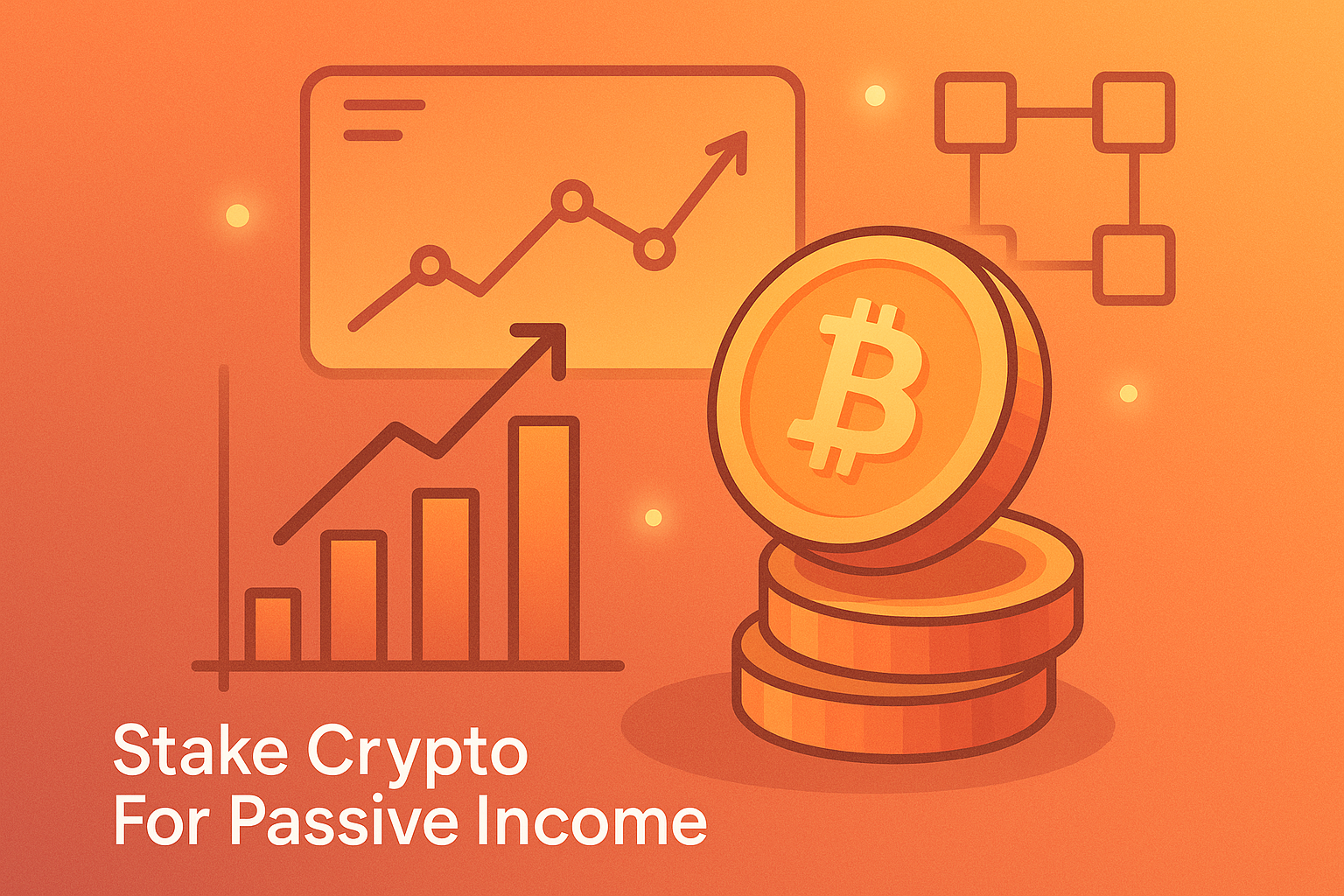Here’s all you need to know about how to stake crypto for passive income.
You went to sleep one night. Woke up the next morning. And, you were a bit richer compared to when you went to sleep. You did nothing actually. No active participation. No charts, and no all-night trading. It was just your crypto quietly working in the background, earning more of itself.
That’s the idea of cryptocurrency for passive income.
As the world of cryptocurrency grows, more people are looking beyond the wild ride of day trading. They want something steady. Yet, something passive. And staking perfectly fits the bill. Instead of constantly buying and selling, you can simply hold certain coins and earn rewards while doing nothing. Well, almost nothing.
So, what is crypto staking all about? How does it work? And, how to stake crypto for passive income? We’re exploring it all today, step by step. You’ll also learn how much you can earn, the best coins to stake, and what risks to watch out for.
Let’s dive in.
What is crypto staking?

Crypto staking is like earning interest on money sitting in your savings account. But better. Instead of your cash lying idle, your crypto gets to work. You lock it up, and in return, you get paid. Simple, right?
But how does it actually work?
At its core, staking is part of a system called Proof-of-Stake (PoS). This is a type of blockchain network that needs people—like you—to help validate transactions. When you stake your crypto, you basically lock up your coins on a network so that it keeps running smoothly. In return, the network rewards you.
Compare that to Bitcoin’s energy-hungry mining process, and staking starts to look like the greener, cleaner option. After all, Ethereum first introduced the idea of staking, and it reduced energy consumption by approximately 99%. You can also see how the energy consumption went down on Crypto Carbon Rating Institute’s index.
Is it smart to stake crypto?
Well, it depends. But let’s weigh it out.
Pros?
- You earn passive income.
- You don’t need expensive gear or technical know-how.
- Once it’s set up, it runs on autopilot.
- It encourages long-term holding (aka “HODLing”), which often leads to fewer bad trading decisions.
Cons?
- The market’s still volatile. Your crypto might lose value, even if you’re earning rewards.
- Some coins require you to lock your funds for weeks or months. During that time, you can’t access or sell them.
- If the validator you choose messes up, you might lose part of your stake (this is called slashing).
So, is it smart? If you believe in a project, want a low-maintenance income stream, and are in it for the long haul—it just might be. We can’t say it for certain because it depends upon each investor’s personal goals.
Is crypto staking passive income?
Absolutely. In fact, it’s one of the easiest ways to earn blockchain passive income.
Once you choose your coin, platform, and validator (more on that later), it’s mostly hands-off. Your wallet does the heavy lifting. Some platforms even auto-compound your rewards. Meaning your earnings grow on their own.
No day trading. No charts, moreover, No stress. However, it’s not entirely “set it and forget it.” But, it’s pretty close.
Is staking a good way to make money?
Short answer? Yes. If you’re patient that is.
Staking won’t make you rich overnight. This isn’t a get-rich-quick scheme. But over time, with the right coins and strategy, it can become a solid stream of income. And compared to more complicated strategies like yield farming or liquidity mining, staking is way easier to understand.
Think of staking as a slow burner. While others chase fast gains and panic sell during dips, you sit tight and let your crypto do its thing.
How much can you make staking crypto?
Let’s talk numbers.
Most staking rewards range from 4% to 20% annually, depending on the coin and platform. Not bad, especially when your coins are just sitting there anyway. Here are some real-world examples:
- Ethereum (ETH) – ~4%–6% per year
- Cardano (ADA) – ~4%–5%
- Polkadot (DOT) – ~10%–14%
- Cosmos (ATOM) – ~15%–20%
Of course, your exact returns depend on a few things:
- The amount you stake
- The current market conditions
- The validator’s performance
- The staking platform’s fees
Also, the more consistent you are, the more you can earn rewards staking crypto over time. Especially if you reinvest those rewards.
So, while staking won’t double your portfolio overnight, it will reward your patience.
Now that you’ve got the basics down, let’s move on to the good stuff: how to stake crypto for passive income. Step by step. Ready? Let’s go.
How to stake crypto for passive income?

Photo by Michael Förtsch on Unsplash
So, you’re ready to let your crypto earn while you chill? Great choice. Staking is one of the easiest ways to grow your digital assets over time without becoming a full-time crypto wizard. But how exactly do you start? This section is your crypto staking guide. It is a step-by-step breakdown that makes the whole process smooth, simple, and beginner-friendly.
Step 1: Choose the right cryptocurrency
Not every coin can be staked. You’ll need to pick one that runs on a Proof-of-Stake (PoS) or similar system. These coins allow you to lock up your tokens and earn rewards just for helping secure the network.
Some of the most popular coins you can stake include:
- Ethereum (ETH)
- Cardano (ADA)
- Solana (SOL)
- Polkadot (DOT)
- Avalanche (AVAX)
- Tezos (XTZ)
- Cosmos (ATOM)
Before choosing, take a look at each coin’s staking rewards, lock-up period, minimum requirements, and overall network stability. Don’t just chase high APY. Go for trusted, active projects with a strong future.
Step 2: Select a staking method
Once you’ve picked a coin, the next step is choosing how to stake it. And guess what? You’ve got options. Let’s walk through the most popular ones.
• Staking via Exchanges
This is the easiest and fastest way for beginners. Platforms like Binance, Coinbase, Kraken, and OKX offer staking services right from your account.
Pros:
- Beginner-friendly
- No need for separate wallets
- Simple interface
Cons:
- Lower rewards (due to platform fees)
- Less control over your assets
- Risk if the exchange is hacked
• Staking with Wallets
If you want a little more control, go for staking with non-custodial wallets like Trust Wallet, Exodus, or hardware wallets like Ledger and Trezor. These let you hold your private keys while still earning rewards.
Pros:
- Better security
- You stay in full control
- Higher rewards in many cases
Cons:
- Setup can be slightly more complex
- You’ll need to keep your wallet updated
• Delegating to a Validator Node
For advanced users, delegating your tokens to a validator is another option. You won’t need to run a node yourself. You just choose a validator from the network and assign your tokens to them.
Pros:
- High staking returns
- More decentralized
Cons:
- You must choose a reliable validator
- Some risk of “slashing” (losing rewards if your validator misbehaves)
Step 3: Set up your wallet and acquire tokens
Now, it’s time to get your crypto ready. If you’re using an exchange, just make sure you have the coin in your spot wallet. For other methods, download the appropriate wallet app or use a hardware wallet.
Buy or transfer the tokens you plan to stake into your wallet. Always double-check addresses before sending. A small mistake could cost you your funds. Also, keep in mind some networks require you to leave a bit of crypto unstaked to cover transaction fees.
Step 4: Stake your crypto and start earning
Here’s where the magic happens.
On most platforms or wallets, you’ll see a “Stake” button. Click it. Choose the amount you want to stake. Confirm the transaction.
And just like that. You’ve joined the world of passive crypto earners.
The network locks up your tokens, and you’ll start receiving rewards based on the amount you staked and the network’s APY. It’s that easy. And the best part? You don’t have to do anything else if you don’t want to.
Step 5: Monitor performance and consider compounding
Sure, staking is mostly hands-off, but don’t disappear completely.
Check your rewards now and then. See how your validator is doing (if you delegated). Watch for any major changes in APY or network updates. Most platforms give you a clean dashboard to track it all.
Want to supercharge your earnings? Try compounding. That means taking your rewards and re-staking them. Over time, this snowball effect can lead to much higher returns.
Just be mindful of gas fees—especially on networks like Ethereum—so you’re not spending more than you’re earning.
What platforms and tools to use for staking?
You’ve got the plan. Now you need the right tools. Let’s look at a few popular choices:
Crypto Exchanges:
- Binance: Huge selection, decent APY, very beginner-friendly
- Coinbase: Great for U.S. users, simple UI, fewer coin choices
- Kraken: Offers both on-chain and off-chain staking
- KuCoin: Good variety, especially for altcoins
Crypto Wallets:
- Trust Wallet: Mobile-friendly, easy to use, supports multiple coins
- Exodus: Stylish desktop/mobile wallet with built-in staking
- Ledger (hardware): Great for long-term stakers who value security
- Keplr (for Cosmos): Excellent for interacting with Cosmos-based projects
What are the pros of exchange staking?
Here are its main advantages:
- Simple setup
- All-in-one platform
- Minimal tech knowledge needed
What are the cons of exchange staking?
Here are its major disadvantages:
- Custodial (you don’t own the private keys)
- Subject to platform outages or restrictions
What are the pros of wallet staking?
Here are its main advantages:
- More secure
- Non-custodial
- Higher trust and decentralization
What are the cons of wallet staking?
Here are its major disadvantages:
- Slight learning curve
- Requires more user involvement
Here are some tips for maximizing staking rewards
Want to squeeze every drop of passive income out of staking? Try these smart strategies:
Go Long-Term
Many platforms offer better rewards the longer you stake. Some even have fixed-period staking with higher APY. Just make sure you won’t need those funds during the lock-up.
Auto-Compound
Choose platforms that let you auto-restake your rewards. That way, your earnings will grow on top of your existing stake without lifting a finger.
Pick the Right Coin
High APY is tempting. But don’t fall for shiny traps. Stick to established, stable networks with solid tech, good security, and active communities.
Watch Fees
Some platforms charge fees for staking or withdrawing rewards. These can quietly eat into your earnings over time. Always read the fine print.
Split Your Stake
Diversify. Instead of staking everything in one coin, spread across a few trusted projects. That way, if one dips, you’re not losing everything.
So there you have it. How to stake crypto for passive income, broken down into bite-sized, easy-to-follow steps. Whether you’re using an exchange or securing your assets in a private wallet, staking can become a powerful way to earn steady rewards with minimal effort.
And the best part? You’re not just making money. You’re also helping secure the future of blockchain technology.
That said, if you’re ready to dive into crypto staking, which coins are actually worth it?
What is the best crypto to stake?

There’s no single “best” coin to stake. That’s not a cop-out. It’s the reality of crypto. Why? Because the “best” depends on you. Your goals, your timeline, your risk tolerance, and your comfort with volatility.
Some coins offer higher returns. Others come with more stability. Some are super easy to stake, while others require a bit more legwork. So rather than chasing one golden token, smart investors build a diverse staking portfolio. That way, you spread out risk while collecting rewards from different networks.
If you’re serious about crypto staking, then you need to stay dynamic and flexible. The crypto space evolves fast. What’s hot today might cool down tomorrow. So, keep an eye on the market, update your strategy, and don’t put all your coins in one basket.
Now, let’s break down 10 of the top coins for staking. Each brings something unique to the table. And together, they give you a strong foundation to start (or grow) your staking journey.
Top 10 Cryptos for Passive Income from Staking
Here are the top performing coins when it comes to staking.
1. Ethereum (ETH)
- Yield Range: 3.5% – 5.5% annually
- Minimum Stake: 32 ETH (solo); 0 ETH (via pooled staking)
- Lock-Up Period: No fixed period, but may take days to withdraw
- Pros: Most trusted smart contract platform; wide ecosystem
- Cons: High minimum for solo staking. Gas fees can be brutal
Ethereum switched to Proof-of-Stake with its upgrade to Ethereum 2.0. It’s solid, secure, and incredibly popular. If you don’t have 32 ETH, no worries. Platforms like Lido, Coinbase, or Rocket Pool let you stake much smaller amounts.
2. Cardano (ADA)
- Yield Range: 4% – 6% annually
- Minimum Stake: None
- Lock-Up Period: None
- Pros: No lock-up. That’s very user-friendly
- Cons: Lower returns; price volatility
Cardano makes staking feel like magic. It’s flexible and simple. Your ADA stays liquid, meaning you can unstake anytime. That makes it perfect for beginners or those who want less commitment.
3. Solana (SOL)
- Yield Range: 6% – 8% annually
- Minimum Stake: Varies by validator
- Lock-Up Period: ~2–4 days
- Pros: High speed and scalability
- Cons: Network outages and centralization concerns
Solana is a high-performance blockchain. Great returns and solid community support. Just make sure to choose a reliable validator and stay updated on network issues.
4. Polkadot (DOT)
- Yield Range: 10% – 14% annually
- Minimum Stake: ~120 DOT (may vary)
- Lock-Up Period: 28 days
- Pros: Strong tech; high yield potential
- Cons: Long unbonding period; slightly complex setup
Polkadot’s yield is one of the best. But that comes with a long lock-up time. If you’re in it for the long haul, DOT can be a great play.
5. Cosmos (ATOM)
- Yield Range: 8% – 10% annually
- Minimum Stake: None
- Lock-Up Period: 21 days
- Pros: Decentralized and fast-growing ecosystem
- Cons: Price volatility; lock-up period
ATOM is part of the growing “internet of blockchains.” It offers solid rewards and supports many validators. Just be ready to wait three weeks if you want to unstake.
6. Avalanche (AVAX)
- Yield Range: 7% – 10% annually
- Minimum Stake: 25 AVAX (delegating)
- Lock-Up Period: 2 weeks minimum
- Pros: Fast transactions; rising ecosystem
- Cons: Not as beginner-friendly
Avalanche has been gaining momentum. The staking rewards are great, and the platform is scalable. If you’re okay with a slightly steeper learning curve, it’s worth considering.
7. Tezos (XTZ)
- Yield Range: 5% – 7% annually
- Minimum Stake: None (via delegation)
- Lock-Up Period: 5 weeks
- Pros: Easy to delegate; low barriers to entry
- Cons: Smaller ecosystem; rewards vary by “baker”
Tezos is one of the earliest PoS projects. Staking (called “baking” here) is easy and can be done right from wallets like Exodus or Ledger. Perfect for set-it-and-forget-it income.
8. Algorand (ALGO)
- Yield Range: 4% – 6% annually
- Minimum Stake: None
- Lock-Up Period: None
- Pros: Super simple; no lock-up
- Cons: Low yield and limited staking options now
Algorand’s staking rewards are automatically added. No validators, no complex setup. Just hold and earn. It’s not the flashiest, but great for beginners.
9. NEAR Protocol (NEAR)
- Yield Range: 9% – 11% annually
- Minimum Stake: Varies (often small amounts)
- Lock-Up Period: 2–3 days
- Pros: High returns; active development
- Cons: Less adoption than top-tier coins
NEAR combines great returns with a user-friendly staking experience. The lock-up is short, and the network’s growing fast. It’s a rising star in the staking world.
10. Binance Coin (BNB)
- Yield Range: 3% – 6% annually
- Minimum Stake: None
- Lock-Up Period: Flexible or fixed
- Pros: Trusted exchange; simple UI
- Cons: Centralized; exchange custody risk
If you use Binance, staking BNB is effortless. You can choose flexible or locked options depending on your needs. Just remember. You’re staking on a centralized platform.
Comparison Table: Top Crypto Staking Coins
| Coin | Yield Range | Min Stake | Lock-Up Period | Best For | Key Notes |
| ETH | 3.5%–5.5% | 32 ETH (0 via pools) | A few days | Long-term holders | Widely supported, gas fees vary |
| ADA | 4%–6% | None | None | Beginners | No lock-up, easy to use |
| SOL | 6%–8% | Varies | 2–4 days | Higher returns | Network stability concerns |
| DOT | 10%–14% | ~120 DOT | 28 days | Long-term investors | High yield, long lock-up |
| ATOM | 8%–10% | None | 21 days | Decentralized supporters | Great validator options |
| AVAX | 7%–10% | 25 AVAX | 2 weeks | Tech-savvy users | Fast-growing ecosystem |
| XTZ | 5%–7% | None | 5 weeks | Passive income lovers | Delegation is easy |
| ALGO | 4%–6% | None | None | True beginners | Auto-rewards, minimal effort |
| NEAR | 9%–11% | Varies | 2–3 days | Yield seekers | Short lock-up, strong returns |
| BNB | 3%–6% | None | Flexible/fixed | Binance users | Convenient but centralized |
Overall…
There’s no one-size-fits-all answer when it comes to the best staking coin. Your perfect pick might be different from someone else’s. And that’s okay. The beauty of staking is that you can mix and match.
Try a few. Test the waters. Diversify your staking strategy like you would a regular investment portfolio. That’s how you reduce risk and maximize rewards.
And remember, the key to learning how to stake crypto for passive income isn’t just about picking the right coin. It’s about staying curious, being consistent, and letting time do the heavy lifting.
What is the risk of staking crypto?

Photo by Erik Mclean on Unsplash
Staking isn’t all sunshine and passive income. Sure, the idea of earning rewards while you sleep sounds like a dream. But, just like every other form of investment, it comes with its own set of risks.
Don’t panic though. This isn’t about scaring you off. It’s about being smart. If you’re serious about learning how to stake crypto for passive income, then understanding the risks is part of the game. And once you get familiar with them, you can manage or even avoid many of the pitfalls entirely.
So, let’s break it down.
Key risks to be aware of…
Here’s what investors need to pay attention to:
Price Volatility
This is the big one. The value of most cryptocurrencies swings like a yo-yo on caffeine. Even if you’re earning 8% in staking rewards, if the token drops 30% in value, you’re still at a loss.
Let’s say you stake $1,000 worth of SOL. You earn $80 in rewards over a year. Great, right? But if SOL’s price tanks and your original investment is now worth $600, that 8% won’t feel like a win anymore.
So yes. Rewards are cool, but price matters too.
Lock-Up Periods
Many staking coins come with lock-up or unbonding periods. That means once your crypto is staked, you can’t touch it for a certain time.
For example, DOT has a 28-day unbonding period. So if the market crashes suddenly, you can’t just pull out your DOT and sell it. You’re stuck watching the value drop, unable to act.
Timing, here, can really test your patience.
Slashing Penalties
Some blockchains have a system called slashing. It’s basically a punishment.
If the validator you’re staking with misbehaves—maybe they go offline too much or try to cheat the system—you could lose a portion of your staked funds. Not fun.
That’s why it’s important to pick your validator like you’d pick a babysitter for your crypto. You want someone reliable, honest, and stable.
Centralization Risk
Staking on centralized exchanges (like Binance or Coinbase) is super convenient. But there’s a catch.
If the exchange gets hacked, freezes withdrawals, or shuts down suddenly (yes, it’s happened before), your funds could be in danger. Not your keys, not your crypto. That saying exists for a reason.
So while central platforms are easy to use, they also carry custodial risks.
Scams and Technical Errors
Sadly, the crypto world still has its fair share of shady players. Fake staking websites, phishing links, and sketchy wallet apps are everywhere.
And even with legit platforms, a simple technical mistake—like sending tokens to the wrong address—can cost you big. Crypto doesn’t come with an “undo” button.
Always triple-check everything.
How to minimize risk (and sleep better at night)?
So how do you stake smart?
Start with diversification. Don’t put all your coins in one network. Spread them across a few solid projects. That way, if one drops or faces issues, the others can still earn.
Next, stick with reputable platforms and wallets. Use trusted names like Ledger, Trezor, or well-reviewed staking services. Don’t chase sky-high yields from unknown apps. Also, do your homework on validators. Look at their uptime, community feedback, and how often they get slashed (hopefully never). Sites like Staking Rewards are helpful here.
Finally, stay informed. Crypto moves fast. Keep an eye on updates, network upgrades, and market conditions. Being proactive makes a huge difference.
Ultimately
Staking crypto for passive income isn’t a “set it and forget it” strategy. Not entirely. But it can be low effort and low stress. If you know what to watch for.
Think of it like tending a small garden. It doesn’t need constant attention, but if you ignore it completely, weeds (or losses) might creep in. So stay curious, stay cautious, and enjoy the rewards as they grow.
Grow While You Sleep
Staking is one of the simplest ways to make your crypto work for you. It’s like earning interest, but with the added thrill of being part of the future of finance. With the right knowledge and a little patience, you can turn your digital coins into a steady stream of rewards.
Sure, there are risks. But every smart move begins with understanding. Staking isn’t some crypto gimmick. It’s a real, trusted strategy used by seasoned investors and beginners alike to grow their holdings without selling a thing.
So why wait?
Start small. Pick a coin you believe in. Do your research. Watch your confidence—and your rewards—grow with time. You don’t need to be a tech genius to begin. If you’ve been wondering how to stake crypto for passive income, now’s the perfect time to try it out. Take that first step today, and let your crypto earn while you rest. Because your money should hustle just as hard as you do.

